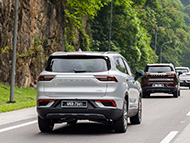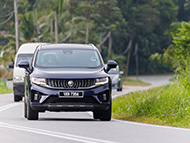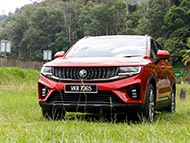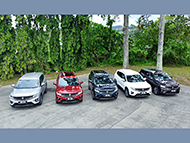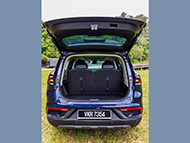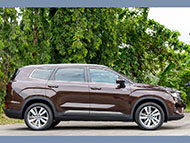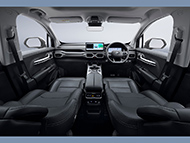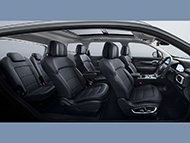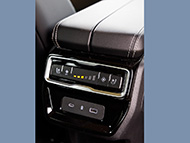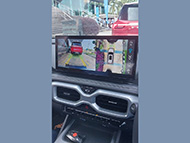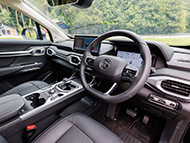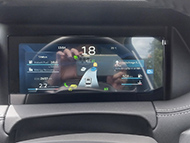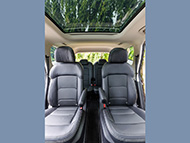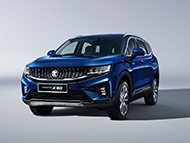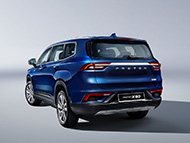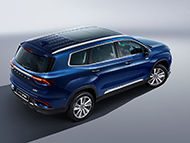By Lee Pang Seng
IT WAS only a matter of time that the Proton SUV (sport utility vehicle) range gets a new flagship and sure enough, the X90 came along to take over from the X70. What was a little surprising was that it came only with 1.5-litre three-cylinder turbo power with no bigger non-turbo engine displacement alternative as that available for the X70.
To play the new flagship role, the X90 is a dimensionally bigger SUV all round against the X70. Its overall length is 4830mm against the X70’s 4519mm and is wider at 1900mm (1831mm) and taller at 1764mm (1694mm). The wheelbase is longer too at 2805mm against the X70’s 2670. Given this scenario, it is heavier varying from 1730 to 1743kg for the four models that are available (X70 1585kg to 1675).
Yet, all four models are powered by the same 1.5-litre turbo engine although it has a little extra over the power units for the X70 and entry-level X50. The Turbocharged Gasoline Direct Injection (TGDi) is a mild hybrid with the addition of a belt-starter generator (BSG) 48V Electric Motor Synergy System (EMS). Thus, all the four models carry this BSG name tag to hail Proton’s first New Energy Vehicle status.
Power-wise, the TGDi engine’s output is similar to that in the X70 at 130kW (177PS) at 5500rpm and 255Nm from 1500-4000rpm. The electric motor in the EMS delivers an additional 10kW (13.6PS) and 52Nm for a combined power output of 140kW (190.6PS) and 307Nm. This drives the front wheels via a seven-speed Dual Clutch transmission with manual mode option.
Would the additional torque and horses be sufficient to handle a heavier SUV? We discovered that the new energy equation worked out well during a two-day media drive between Proton’s COE (Centre of Excellence) and Gambang, Pahang. And this took into consideration that we had four people on board, along with light luggage and work paraphernalia.
There was no sluggish pace and the X90 (the model we drove was the 1.5 TGDi BSG Premium) moved effortlessly in urban and highway traffic. In fact, we noted similarities with the X70 1.5 TGDi that we drove to Desaru, Johor a year ago. On the highway, there was the same mild turbo lag when we hit the accelerator pedal to gain speed for passing slower vehicles. The additional EMS output was just sufficient to move the X90’s greater vehicle weight.
This time though, we learnt that this turbo lag was more pronounced when driving along winding B-grade roads. On hitting the accelerator pedal hard, we didn’t get an immediate engine response in power build-up that would have given us the confidence to overtake quickly. We decided not to push our luck here unless we had a clear stretch to do so with a clear view of oncoming traffic.
In the X70 drive experience, we learnt about this turbo lag during hard initial acceleration as the turbo power only ramped up after an agonising lag. Back then, we didn’t come across this turbo lag during B-road drives probably because we were going at a faster pace and did not encounter crawling traffic. It could also be that the X70 was a lighter SUV and we only had three on board, including the driver.
In all respect, the X90 would meet most needs as a big people mover driven at a comfortable and leisurely pace. You could still drive it at a robust speed along the highway, hitting illegal speeds rather effortlessly to catch the attention of the police speed cameras.
The X90 1.5 TDGi BSG Premium we drove featured Nappa leather seats but the back support seemed to be different for the driver and the passengers. We noticed that the lumbar support for the driver was firmer and comfortably softer for the passengers. It is a two-way adjustable support system but we didn’t select the other option as we were comfortable with the harder lumbar support.
Another feature was the shorter seat squabs that led to less than desirable thigh support. This is one of the ways to create more passenger space. Surprisingly, we didn’t suffer tired thighs from the lack of support either as driver or passenger. Perhaps, it was because we took turns to drive and change seating arrangement to experience a fuller aspect of the X90. In any case, we even took the opportunity to catch 40 winks while lounging in the second-row seats.
The short gearshift is pretty Volvo-ish in design and straight forward in gear selection, much like that of the conventional design gearshift. The X90 centre console design is among the few that has two levels, with a lower section for storing minor items.
As the flagship SUV in the Proton stable, the X90 comes with a longer list of standard items, even for the lower models. All four models come with LED (light emitting diode) headlamps and daytime running lights, and front sequential turn indicators. However, only the top three models have the Auto Rain Sensing front wipers and Power Tailgate.
There are also other features that support its flagship status for all four models such as the Walk Away Door Lock, Remote Engine Start and power windows for all four doors with the anti-trap feature. Like the X70, only the flagship model has the panoramic sunroof though the X90 Flagship goes one better with Captain seats for the second row. All the other models have the 60:40 split fold second-row seats.
For the infotainment system, the X90 stamps its flagship status with a 12.3-inch touchscreen monitor on the centre dashboard area (the X70 has an eight-inch unit) with the full suite of functions also found in the X70. The X90, however, boasts of wireless handphone chargers for the top two models. Interestingly though, the X90 has a six-speaker arrangement for all models unlike the X70, which has up to nine speakers with power amplifier and subwoofer for the top two models.
The X90 also has a longer list of safety and security features, including a series of lane keeping items for the top two models along with Traffic Sign Information and Intelligent Cruise Control (ICC) while only the Flagship has the Digital Video Recorder. Features like the Rear Cross Traffic Alert, Rear Collision Warning and Lane Change Assist are standard to all four models. Meanwhile, the 360 Camera with 3D Display is only available in the top three models as the bottom X90 Standard comes with a reverse camera.
We put the ICC to the use during the times we were caught in traffic crawls, especially along the 30km detour we had to take due to the large sinkhole along the Karak Highway. The system would bring the X90 to a complete stop if the system detects the front vehicle doing so. To get moving again, we had to prompt the accelerator pedal as the ICC does not have a ‘get moving’ function. For sure, it made crawl driving a little easier as we did not have to work the accelerator pedal other than to get the SUV moving again.
For its larger and taller body, the X90 took well to winding B-grade roads and fast sweepers without much body roll. The stabilisers or anti-roll bars certainly did their job keeping the X90 on a level poise through winding roads. It is independently sprung all round with MacPherson struts in front and multi-link set-up at the rear.
The tyres fitted to the X90 Premium that we drove were 235/50 R 19 Continental EcoContact 6 on alloy wheels (the lower two models have 225/55 R18 tyres). They complemented the X90 suspension system to provide a comfortable ride on the highway although the detour section with not-so-good B-grade roads resulted in a slightly jarring ride, felt clearly from the second-row seats.
We didn’t get to experience this aspect of the X90 from the 50:50 split third-row seats as we had folded them away to accommodate our luggage and work equipment (Proton put four media people to an SUV). The luggage space with the third-row seatrests up wouldn’t be enough as it’s good only for three medium bags at most.
We could discern the air turbulence along the roof and top section of the front windows at highway speeds but the light rustle was easily overlooked. Like most modern vehicles, the greater noise intrusion into the interior was the road roar generated by the tyres over the respective road surfaces and this came in varying pitches for the different tarmac surfaces. For sure, you could tell a bad road surface from the higher noise that is generated.
At the end of the drive, we could clearly relate to the X90 as a large SUV for comfortable motoring although it held its own well too through winding roads. And the best part is the price; the X90 Premium we drove is RM144,800 on the road without insurance. The Flagship costs about RM8000 more while the X90 Standard is priced about RM122,000 and X90 Executive about RM129,000.
Specifications
Proton X90 1.5 TDGi BSG Premium
Engine: 1,477cc, inline 3-cylinder, 12-valve, DOHC, turbo direct injection, 48V Motor Synergy System
Maximum power: 177PS at 5,500rpm
Maximum torque: 255Nm from 1,500 to 4,000rpm
Electric motor output: 13PS and 45Nm of torque
Transmission: Seven-speed dual-clutch
Autonomous Emergency Braking (AEB), Forward Collision Warning (FCW), Rear Collision Warning (RCW), Adaptive Cruise Control (ACC) with Stop and Go, Intelligent Cruise Control, Lane Departure Warning (LDW), Lane Departure Prevention (LDP), Lane Centering Control (LCC), Emergency Lane Keep Assist (LEKA), Lane Change Assist (LCA), Rear Cross Traffic Alert (RCTA), Tyre Pressure Monitoring System (TPMS), Auto Park Asist (APA), 360 Camera with 3D Display, Nappa leather steering wheel and
